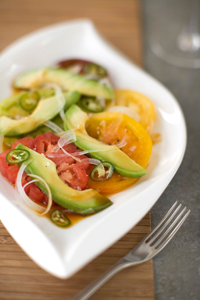Home » Asian for a New Generation » Understanding Umami

Although chefs have long known that some ingredients—anchovies and soy sauce, for example—give dishes greater depth of flavor, they haven’t always understood why. The answer lies in the groundbreaking research of a Japanese scientist named Kikunae Ikeda. In 1908, while trying to understand what made dashi broth so flavorful, Ikeda identified a “fifth taste”—umami, or, in Japanese, “deliciousness.” He traced its source to glutamic acid, an amino acid plentiful in the seaweed and dried bonito flakes used in dashi.

For years, scientists thought there were only four primary tastes—tastes that can’t be produced by combining others. Twentieth-century scientists debated whether umami was a true primary taste on par with sweet, sour, salty and bitter. But after researchers proved that umami foods could produce electrical signals in taste nerves, and after neuroscientists at the University of Miami found taste-bud receptors on the tongue for umami, the legitimacy of the “fifth taste” was no longer disputed.
Glutamic acid, the amino acid responsible for the umami sensation, occurs naturally in many foods, such as truffles, tomatoes and scallops. It is present in proteins and in foods that are aged or very ripe, or have been brewed or fermented, such as mushrooms, aged cheese, red wine—and soy sauce. Adding brewed soy sauce to any savory menu item can help its natural flavors “pop,” making foods taste richer and more fully rounded without necessarily adding a pronounced Asian flavor.
In the West, chefs sometimes think of soy sauce as a savory condiment for Asian foods. They’re right, of course. But that’s just the beginning.

Kikkoman Soy Sauce also offers the advantage of umami, a taste that can’t be created artificially. Umami is the fifth primary taste—in addition to the traditional sweet, sour, salty and bitter taste sensations—and has been described as “savory” or “brothy.”
The types of molecules responsible for umami flavor vary from one food to another. When chefs pair two umami-rich foods, these molecules combine to produce more than the simple sum of their parts, creating “umami synergy”—the “two-plus-two-equals-wow!” effect you get when you pair soy sauce with beef, pork, chicken, seafood, mushrooms or tomatoes. In other words, soy sauce can be “instant umami.”
It’s this connection to umami that makes Kikkoman Soy Sauce one of the most versatile food ingredients available. And that versatility has been the key to Kikkoman’s success in bringing soy sauce into the American mainstream.
Making food with memorable flavor is every chef’s ambition. You’ll find it helpful to understand the principle of flavor enhancement—how to use tart flavors to balance sweet ones, for example, or sugar and acid to counter chile heat. But sometimes dishes simply have a flavor hole that no amount of salt, sugar or lemon can fill.
When that happens, chefs familiar with umami will turn to umami-rich foods to supply that missing link. Southeast Asian fish sauce, anchovy paste or soy sauce—all rich in umami-can add depth, or what some chefs call “resonance,” to a dish.
After adding an umami-rich flavor enhancer like soy sauce, you’ll perceive an improvement in the dish before you detect the enhancer. In other words, just a few drops of soy sauce in, say, black bean chili or meatloaf can deepen the flavor without making the dish taste Asian.
Traditionally brewed soy sauce contributes a full, robust sensation and heightens perceptions of all the flavors in the dish. One California chef says this umami ingredient can make the flavor of a dish seem to be “in more vivid color.”

To convince yourself of the umami power of soy sauce, try these experiments:

What makes soy sauce different from other umami ingredients is its versatility. A chef wouldn’t add a pinch of Parmesan cheese or chopped mushrooms to just anything he or she cooks. However, traditionally brewed Kikkoman Soy Sauce, which contains more than 300 distinct flavor and aroma components, is an easily incorporated liquid that’s convenient to use and store.
The key to creating synergy between umami-rich ingredients and soy sauce is balance. In most cases—especially when working with non-Asian foods—you want the soy sauce flavor to remain in the background, so that you perceive its salty, sweet, meaty qualities without identifying a pronounced soy sauce taste. So go slowly at first, as you would with salt or pepper, seasoning to taste until you get the proportions right.
Try these quick recipes and see how easy it is to add umami:
Asian Cool® is a registered trademark of KIKKOMAN CORPORATION.
Umami Made Easy® is a registered trademark of KIKKOMAN CORPORATION.
Hyde Park, NY Location
1946 Campus Dr. | Hyde Park, NY 12538
Maps & Directions
Napa, CA Location
500 First Street | Napa, CA 94559
Maps & Directions
Singapore Location
21 Tampines Ave 1 Block 31 | Singapore 529757
Maps & Directions
St. Helena, CA Location
2555 Main St. | St. Helena, CA 94574
Maps & Directions
San Antonio, TX Location
312 Pearl Pkwy, Bldg 3 | San Antonio, TX 78215
Maps & Directions